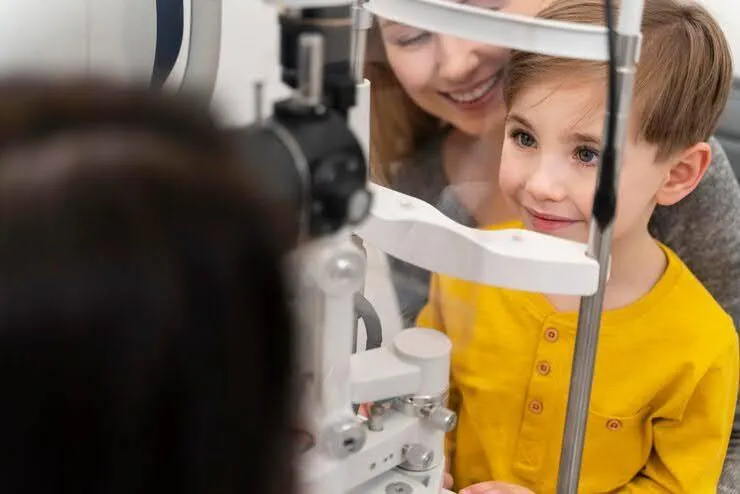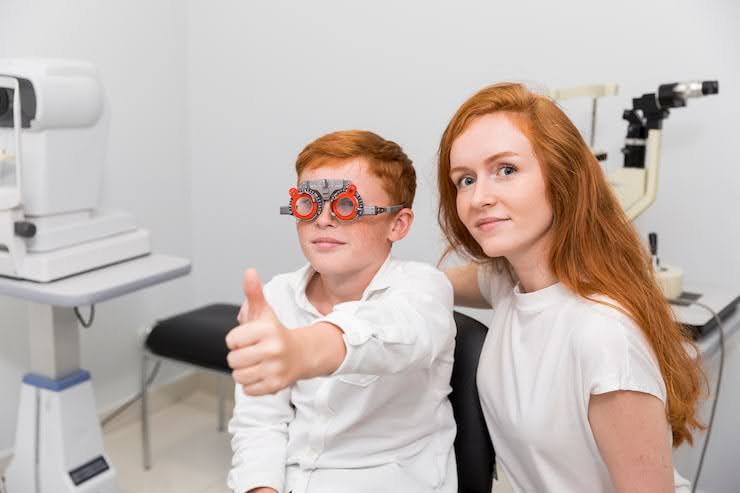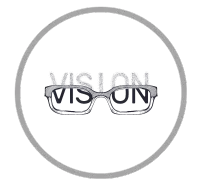Myopia Care
Myopia Control Costs Clearly Explained
FSDAVCFEBFEVSDDVFSD
FSDAVCFEBFEVSDDVFSD
FSDAVCFEBFEVSDDVFSD
What Myopia Control Programs Typically Include
When evaluating myopia control cost, most first-year programs at a Houston myopia clinic like Kleinwood Vision include key baseline exams such as refraction, corneal topography, and axial length measurement. Packages often cover lens or atropine fitting, insertion and removal training, initial follow-ups, and a set number of adjustments. Items like cleaning solutions, cases, and backup glasses may be additional out-of-pocket costs.
In following years, costs are typically lower unless major treatment changes are needed. Regular axial length monitoring is critical in pediatric myopia management. This ongoing care ensures the treatment stays effective, adapting as your child’s eyes grow and preserving long-term value.
When evaluating myopia control cost, most first-year programs at a Houston myopia clinic like Kleinwood Vision include key baseline exams such as refraction, corneal topography, and axial length measurement. Packages often cover lens or atropine fitting, insertion and removal training, initial follow-ups, and a set number of adjustments. Items like cleaning solutions, cases, and backup glasses may be additional out-of-pocket costs.

In following years, costs are typically lower unless major treatment changes are needed. Regular axial length monitoring is critical in pediatric myopia management. This ongoing care ensures the treatment stays effective, adapting as your child’s eyes grow and preserving long-term value.

Ortho-K, MiSight®, Atropine Cost Profiles
Understanding the Ortho-K price helps families plan their budgets effectively. Typically, the cost includes fitting exams, custom overnight lenses tailored to your child’s eyes, solution starter kits, and scheduled follow-up visits to monitor progress. Many providers offer warranties that cover lens replacements due to early fit adjustments or defects. However, replacement lenses may be necessary over time due to loss, damage, or prescription changes, which can add to overall expenses.
The cost of MiSight lenses is largely driven by the yearly supply of daily disposable contact lenses and regular checkups. Consistency in wearing the prescribed lenses daily and following the recommended wear schedule is crucial for both achieving effective myopia control and managing costs. Missing or extending wear can impact outcomes and increase the need for additional visits or adjustments.
Atropine eye drop costs vary depending on the concentration prescribed, compounding pharmacy fees, and bottle size. Families should expect periodic refills and ongoing follow-ups to adjust treatment as needed. Growth spurts, school schedules, and lifestyle changes can influence drop wear times and reorder timing, making regular reviews essential to keep treatment effective and avoid unnecessary costs.
Understanding Value Through Treatment Outcomes

When managing myopia, it’s important to compare the dollars spent with the millimeters of axial growth saved. Slower axial length growth means a lower risk of retinal complications later in life and can reduce future healthcare costs. Choosing a treatment plan your child can consistently follow is more effective than selecting a “perfect” but difficult one. Consistency leads to better outcomes, greater comfort, and long-term success.
At Kleinwood Vision, we recommend reviewing your child’s progress every 3 to 6 months. If axial growth exceeds target levels, treatment adjustments can be made to improve control and effectiveness.

These timely modifications help ensure that the myopia control cost you invest delivers real-world protection for your child’s vision and overall eye health. Regular check-ups and personalized care are essential to maintaining healthy eyes and maximizing the benefits of treatment as your child grows.
Many families use FSA or HSA funds to help cover myopia control cost, making treatment more affordable and manageable. Setting reorder calendars is a smart way to avoid gaps in lens wear, ensuring consistent vision correction and myopia management. Keeping unopened lens boxes is important as it allows for easy exchanges if prescriptions change, saving time and money. At your Houston myopia clinic, be sure to ask about warranty periods, travel kits, and discount bundles—these are especially useful for families managing myopia in multiple children.
While combination therapy may increase short-term costs, it often provides better control for fast myopia progression. Investing in more comprehensive treatment can lead to improved long-term outcomes and potentially reduce the risk of complications later. Discussing all available options with your eye care provider helps you choose the best plan tailored to your child’s needs, balancing cost with effectiveness in managing pediatric myopia.
Hidden Costs and Planning Ahead
Budget for extras like cases, saline vials, and retraining after breaks to avoid unexpected myopia control costs. It’s important to clarify with your insurance provider what’s covered under medical versus vision plans, as imaging and exams may be billed separately. Knowing this helps you plan expenses and avoid surprises.
Maintain a yearly planner for refills, follow-ups, and lens warranties to stay organized and on track. Consistent routines are crucial for success—busy schedules with late sports or heavy homework can disrupt lens wear, which may affect treatment results. Inconsistent wear can lead to increased myopia control costs due to replacement lenses or missed visits. Staying proactive with scheduling and care ensures the best outcomes for your child’s vision and overall eye health.
Choosing a Plan That Sticks
Start by giving a comfort and handling score based on your child’s specific needs and your family’s daily schedule. Consider how easy it is for your child to insert and remove the lenses, and how well the lens routine fits into your busy life.
Next, set a budget range and preferred check-in cadence that aligns with your axial length outcome goals. This helps create a plan that balances cost, convenience, and effectiveness while supporting your child’s eye health.
Start by giving a comfort and handling score based on your child’s specific needs and your family’s daily schedule. Consider how easy it is for your child to insert and remove the lenses, and how well the lens routine fits into your busy life.
Next, set a budget range and preferred check-in cadence that aligns with your axial length outcome goals. This helps create a plan that balances cost, convenience, and effectiveness while supporting your child’s eye health.

Pick a myopia control plan you can consistently follow for a full year before reassessing. Use data from follow-ups rather than guesswork to make informed decisions. At Kleinwood Vision, we guide families toward realistic, sustainable solutions in pediatric myopia management to protect your child’s vision while fitting your lifestyle and budget.

Pick a myopia control plan you can consistently follow for a full year before reassessing. Use data from follow-ups rather than guesswork to make informed decisions. At Kleinwood Vision, we guide families toward realistic, sustainable solutions in pediatric myopia management to protect your child’s vision while fitting your lifestyle and budget.
Scripts, Checkpoints, and Calm Decisions
Before beginning your child’s myopia management treatment, it’s crucial to establish clear treatment triggers with your eye care provider. For instance, if axial length growth exceeds agreed-upon targets twice, your clinician may recommend adjusting the lens fit or adding another therapy to better control progression. Similarly, if your child’s comfort level drops below 7 out of 10 for a week or more, retraining on lens handling and assessing for dryness or irritation can improve comfort and encourage consistent wear.
Regular follow-ups are essential for tracking progress and addressing any issues early. Schedule appointments at 6–8 weeks and again at 3–6 months. Bring your child’s wear logs, lens care products, and any questions to these visits. Unexpected expenses can arise due to lost lenses or rapid eye growth, so discussing warranty coverage, treatment pauses, or switching lens types can help manage costs without compromising care.
It’s important to keep thorough records of all changes, including treatment modifications, comfort scores, and axial length measurements. Having clear goals and documented dates reduces surprises and helps ensure steady progress. This ongoing documentation also allows for better communication between your family and the provider, ensuring that everyone stays informed and aligned.
At the year-end review, compare the overall myopia control costs with your child’s treatment outcomes. This assessment helps determine whether to continue with the current plan or make necessary adjustments for better results. Kleinwood Vision remains available throughout your child’s myopia management journey to provide support, guidance, and expert care to protect your child’s vision for the future.
Parent FAQs: Dollars & Decisions
Do we still need glasses? Yes—backup glasses remain essential for times when lenses aren’t worn, ensuring clear vision and safety. Having spare glasses helps protect your child’s vision during activities when lenses aren’t practical. What if a lens is lost? Contact us promptly; warranties or discounted replacements may apply to avoid extra costs and keep treatment on track.
Can therapy pause in summer? Sometimes—check with your Houston myopia clinic to understand how breaks might affect your child’s progress and outcomes.

Do we still need glasses? Yes—backup glasses remain essential for times when lenses aren’t worn, ensuring clear vision and safety. Having spare glasses helps protect your child’s vision during activities when lenses aren’t practical. What if a lens is lost? Contact us promptly; warranties or discounted replacements may apply to avoid extra costs and keep treatment on track.
Can therapy pause in summer? Sometimes—check with your Houston myopia clinic to understand how breaks might affect your child’s progress and outcomes.
Each case is unique, so professional guidance is important before pausing therapy. Will year two cost less? Often yes, especially if your child’s eye growth stabilizes, which usually reduces treatment needs and expenses.
How do we know it’s “worth it”? Track axial length changes and comfort regularly. Sustained results protect your child’s vision long-term. Consistent appointments and monitoring ensure therapy effectively slows myopia progression and supports eye health over time.
Each case is unique, so professional guidance is important before pausing therapy. Will year two cost less? Often yes, especially if your child’s eye growth stabilizes, which usually reduces treatment needs and expenses.
How do we know it’s “worth it”? Track axial length changes and comfort regularly. Sustained results protect your child’s vision long-term. Consistent appointments and monitoring ensure therapy effectively slows myopia progression and supports eye health over time.
Budget-Smart Plan: Your Action Guide
Set aside a monthly budget for essential supplies such as lenses, cleaning solutions, and cases, and be sure to schedule follow-up appointments ahead of time. Keeping a small emergency fund for unexpected replacements or visits helps prevent sudden, costly surprises. Regularly review your child’s wear logs and treatment progress to catch any issues early and adjust the plan before problems grow.
At Kleinwood Vision, families who maintain clear treatment goals, consistent check-ins, and organized supply orders often achieve strong myopia control outcomes. This disciplined approach supports predictable myopia control costs and helps ensure long-term eye health. Proactive management keeps your child’s vision stable while avoiding unforeseen expenses. Contact Kleinwood Vision to start a personalized, budget-friendly myopia control plan tailored to your child’s unique needs and lifestyle. With careful planning, you can protect your child’s vision while managing costs effectively.

Contact Info
Hours of Operation
Mon - Fri | 9:00 AM - 5:00 PM
Sat - Sun | Closed
Holiday Hours: We are closed for the following holidays: New Years Day, Memorial Day, Independence Day, Labor Day, Thanksgiving Day, Christmas Day
© 2025 Kleinwood Vision. All rights Reserved.


